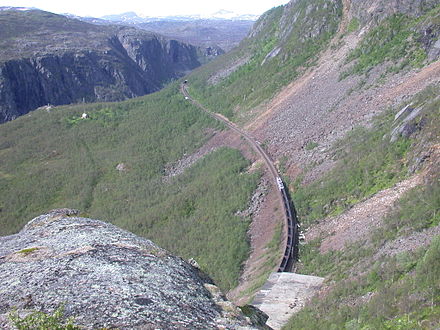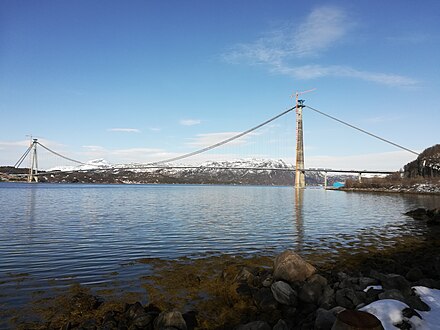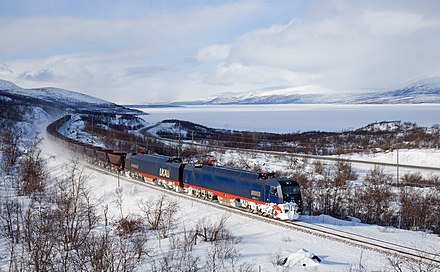Narvik - settlement in Narvik Municipality, Norway

Narvik is a city in Nordland in northern Norway. The town of Narvik has a population of about 14,000, while the entire municipality has a population of about 18,000. The city sits along the southern shore of the Ofot Fjord, and is the centre of the Ofoten district.
Understand
See also: Norrbotten megasystem
The modern city was founded in 1902. It grew up as an important ice-free port for Swedish iron ore exports. Before the port and the iron-ore railway was constructed there were only a few farms on the peninsula. During the first attempt to establish a port and railway the place was called Victoriahamn (Victoria port), after the visit by Crown Princess Victoria of the joint kingdom of Sweden and Norway. When the iron ore railway (known as Ofotbanen in Norway and Malmbanan for the entire 500 km between Narvik and Luleå) was finally built from 1898 to 1902 there was an intense activity in Narvik and particularly in the mountains. Thousands of navvies poured in and created a temporary city at Rombaksbotn. The railway construction from Narvik through the wild mountains until the plateau on the Swedish side was a notable engineering achievement. The railway was electrified as early as 1923. Control of the iron ore fields at Kiruna and the port of Narvik was a key motive for German attack in 1940 and the allied intervention.
 During and after the German invasion of Norway, Narvik was the scene of fierce battles between allied (British, French and Polish supporting Norwegian army) and German forces, and the war museum commemorates the events of 1940. The Battle of Narvik was the first real engagement between Allied and German troops after months of phony war. The Battle of Narvik was a key event in the early phases of the war. The town was totally destroyed in the process and the fjord was full of shipwrecks. Some 20 major war ships sunk during the battle at Narvik. Today, the city offers several outdoor activities; in particular, alpine skiing is possible in the mountains around Narvik.
During and after the German invasion of Norway, Narvik was the scene of fierce battles between allied (British, French and Polish supporting Norwegian army) and German forces, and the war museum commemorates the events of 1940. The Battle of Narvik was the first real engagement between Allied and German troops after months of phony war. The Battle of Narvik was a key event in the early phases of the war. The town was totally destroyed in the process and the fjord was full of shipwrecks. Some 20 major war ships sunk during the battle at Narvik. Today, the city offers several outdoor activities; in particular, alpine skiing is possible in the mountains around Narvik.
The Narvik district is called Ofoten, which is the original name of the fjord now known as Ofotofjorden. The fjord is some 500 meters deep in the central parts, more shallow in the inner part. Some wrecks from the Battle of Narvik rest at only 10-20 meters. In Rombaken, the inner branch of the big fjord, there is one wreck above the water line.
Get in
By plane
- Harstad/Narvik Airport, Evenes (IATA: EVE), 68.4913°, 16.678108°. It also serves the town Harstad. There are several direct flights daily from Oslo. Flights are also available from Trondheim, Bodø, Tromsø, and other mid-sized Norwegian cities. Also used by charter flights. This airport is located 55 km from Narvik; airport buses makes the journey in about 50 minutes costing in 100-300 NOK range.
By rail

.png/440px-Map_of_Malmbanan_(section).png) Narvik is the terminus of Malmbanan ("Iron Ore Railway", in Norway known as Ofotbanen) railway from northern Sweden. Mainly used for shipping enormous amounts of iron ore from mines in Lapland, it also offers passenger services.
Narvik is the terminus of Malmbanan ("Iron Ore Railway", in Norway known as Ofotbanen) railway from northern Sweden. Mainly used for shipping enormous amounts of iron ore from mines in Lapland, it also offers passenger services.
Narvik is not connected directly to the rest of the Norwegian rail network, which ends in Bodø, 150 km southwards. You can book connecting rail and bus tickets from southern Norway via Vy.
- Narvik Station, 68.441667°, 17.441667°. 2018-06-20
A journey along Malmbanan gives spectacular views over large mountains of Narvik and the vast emptiness of Lapland. The Norwegian state railway company Vy has two daily services; one early morning and another at around 10:00 from Luleå (7 hr) via Boden (6½ hr), Gällivare (4½ hr) and Kiruna (2 hr 45 min). The morning service has sleeper carriages attached all the way from Stockholm, departures from Stockholm are daily at 18:00. Prices vary according to demand, booked early (bookings open 90 days before departure) tickets for the over-night trains can be as low as kr 450 and kr 195 for day trains. Narvik is the northernmost point that can be reached by train on electrified standard gauge railways from the rest of Europe.
By bus
There are long-distance bus lines from Fauske, Kiruna, Lofoten and Tromsø, and from several nearby places. Many routes are very scenic.
- The bus station, Narvik rutebilstasjon 📍, is on the west side of the inner city, near the AMFI shopping center. Buses to or from north also stop undefined 📍 at E6 near the railway station on the other side of the city. A full timetable can be found at Reis Nordland.
Get around
Narvik is a compact city which is easy to navigate. The tourist information office is on the main street, and the railway station is easy to find as well. Destination Narvik and its links will help you to find most of what you are looking for about Narvik.
If flying in from Oslo Gardemoen to Harstad/Narvik/Evenes airport west of Narvik, a one-hour bus transit is available right to the town centre.
Narvik has a local bus service with routes to neighborhoods outside the centre, including Ankenes, Framnes, and Beisfjord. Tickets for short journeys are kr 31, kr 16 for children (under 16) and seniors (67 years and over). Most lines run Monday to Saturday, while a few major routes (in particular Ankenes) have very limited service Sunday afternoons as well. Schedules are available online (in Norwegian); the paper schedule for the Ofoten region can also be downloaded.
See
- Ofoten Museum, Administrasjonsveien 3, 68.4317489°, 17.4252468°, +47 76-969650.
- War Memorial Museum (Nordland Røde Kors Krigsminnemuseum), Torgsvingen 15, 68.437988°, 17.4283192°, +47 76-944426, kmmu@warmuseum.no. Exhibitions about the Narvik Campaign in the Second World War.
- Narvik church, 68.4396°, 17.4133°. Large stone church was built in 1925 by the architect Olaf Nordhagen. 2015-04-13
Do

- Take the cable car to the top of Fagernesfjellet. Or better yet, climb it in the middle of the night during summer. There is a fantastic path the winds up the mountain that overlooks the city and one can reach the same destination as the cable car.
- Ski at Narvikfjellet, 68.432°, 17.448°. The ski station is located so that you can contemplate the fjords as you ski down the slopes. ≈400 NOK 2022-04-14
- Voss Klatrepark. Fun climbing park through treetops, open all year round. 2015-04-13
- Hiking from Beisfjord, 68.3597°, 17.6118°. July–September. There is a good network of hiking routes in the inland. The nearest trailhead is at Beisfjord, 12 km south-east from the city. A weekend hike up to Lossihytta hut at some 750 m (25 km one way) requires fitness and some experience (two fords). The hike can be extended as a five-day tour around Storsteinsfjellet (return by train from Katterat). The huts require the DNT key, otherwise you must bring a tent. 2017-04-08
- Hiking from Katterat, 68.39738°, 17.96578°. Jun–Sept. Take the train to Katterat and hike to Hunddalshytta. You can continue via Oallavagge day hut, Čunojávrihytta, Unna Allakas fjällstuga and Abiskojaurre fjällstuga to Abisko: 70 km, 5 days. The last leg is by Kungsleden, the most famous hiking route in Sweden. Enjoy the facilities of Abisko fjällstation. Return by train. The DNT key is needed for the first huts, Unna Allakas is unlocked, the last are manned. The trail is classified as requiring normal fitness and basic hiking skills (on the Norwegian scale). 2017-04-08
Buy
There are shops and kiosks on the main street, plus there are two large shopping centres: one near the railway station and the other in the centre of the town.
Connect
Eat
- Linken Restaurant Og Bar, Kongensgate 64 (At Quality Hotel Grand Royal), +47 96-99660.
Drink
- Malmen/Telegrafen, Dronningens gate 47, 68.4382092°, 17.4300913°, +47 76-960055.
- Tøtta Bar, Kongensgate 33 (On the eighteenth floor of Rica Hotel Narvik), +47 76-961400. M-F 11AM:00-01:00, Sa Su 11:00-02:00. Great bar to start off the evening with drinks and perhaps a light meal while taking in the dramatic mountainous landscape.
Sleep
 For a town of its size Narvik offers a large selection of hotel, both more high-end and cheaper alternatives.
For a town of its size Narvik offers a large selection of hotel, both more high-end and cheaper alternatives.
- Quality Hotel Grand Royal, Kongensgate 64, 68.4404222°, 17.4333311°, +47 76-977000, q.royal@choice.no. Largest hotel in town with over 600 beds, much-used and well-suited for larger conferences.
- Scandic Narvik, Kongensgate 33, 68.4367966586754°, 17.4259846600494°, +47 76-961400, narvik@scandichotels.com. Newest hotel to open in Narvik, this 18-story high rise offers great views over the town and surrounding mountains. Offers stylish interior design and a skybar. 2015-04-22
- Best Western Narvik Hotell, Skistuavn. 8, 68.437712°, 17.447705°, +47 76 96 48 00, narvik@bestwestern.no. 40 rooms 2015-04-22
Go next

- The Express Bus (northbound) goes to Finnsnes and Tromsø with connections to Alta and the North Cape. The southbound to Fauske (railway) and Bodø (bus, railway and airport)
- Southbound bus to Fauske/Bodø daily
- There are two bus departures daily from Narvik to Svolvær in Lofoten
- There is an Airport Express Bus to Harstad/Narvik/Evenes Airport (EVE) that connects with flights to Oslo Gardermoen Airport (OSL).
- Kiruna and Luleå in Sweden, connected by road and Malmbanan (Iron Ore Railway, known as Ofoten Line in Norway)
Narvik
narvik.kommune.noNarvik
2nd-order administrative division
Nordland
Primary administrative division
